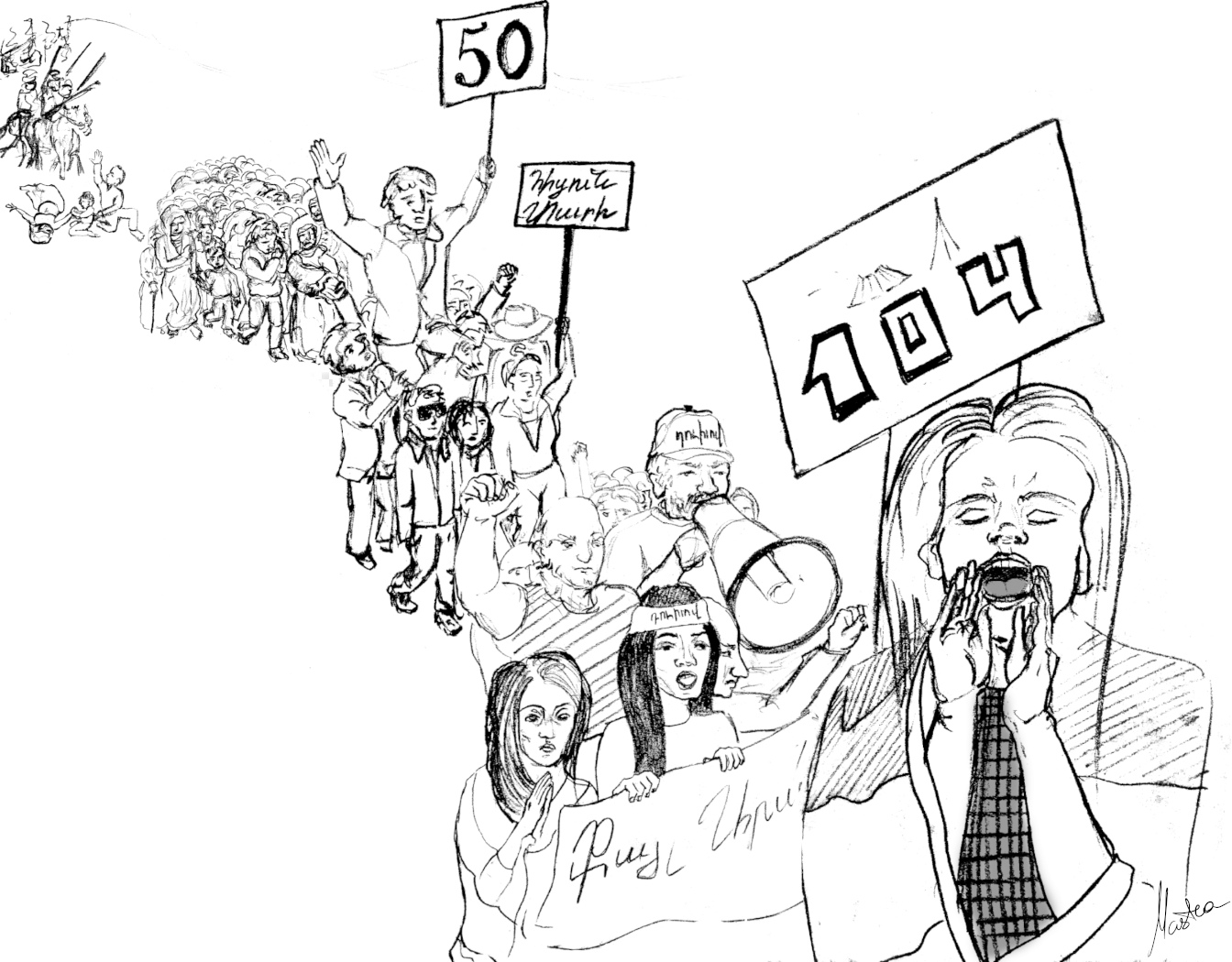
If there’s anything I’ve learned running a Diasporan newspaper, it’s that there seem to be—at any given point—a million reasons for Armenians in the Diaspora to disagree with one another. We are by no means an ideologically homogeneous people. This has much to do, I’m certain, with our geographic dispersion. But while we may not agree on a great many things, there is one indisputable point around which we all converge every year in a spectacular show of consensus. Liberals, conservatives, old, young, American, Russian—all come together on April 24 so that our voices can grow loud enough to pierce through the white noise of the political moment.
We’ve worked hard as a community to earn the spotlight on April 24, which is the culmination of decades of activism. It pays off; each year, the Armenian Genocide is referenced and discussed in countless opinion pieces, news articles, TV stories and more, on both the local and international level. Demonstrating doesn’t just honor the victims of 1915; it’s also a strategic show of the strength in contemporary numbers, as well as an opportunity to expand the capital-C cause, reach new people, inform the uninformed and reinvigorate. After all, there are a lot of us. And the more ways we can discuss or approach the injustice, the better. At least, in theory.
It can’t have been a coincidence that what we now call the Velvet Revolution happened around the time of the annual Genocide commemorations. It is the one day a year the international community tunes into the Armenian struggle.
On April 24, 2018, the Diaspora went about its yearly demonstrations. Everything went as planned; it was business as usual. But strangely, the situation could not have been more unusual. Just the day prior, the people of Armenia embarked on a historic revolution of near epic proportions. In a matter of weeks, they had secured a peaceful and bloodless transition of power, discarding a deeply corrupted regime through the will of the people. It was democracy at work, at a time when modern instances of genuine and nationwide consensus are rare (not just in Armenia, but everywhere).
It can’t have been a coincidence that what we now call the Velvet Revolution happened around the time of the annual Genocide commemorations. This is, after all, the one day a year the international community tunes into the Armenian struggle. Thanks in no small part to dedicated individuals activists and organizers dispersed across the Diaspora, the leaders of the Velvet Revolution had a day of strategic publicity built into their calendar, which they used, well… strategically. I doubt Serzh Sargsyan would have so readily abdicated his grip over the country had the timing not been so. It was a miraculous display of pan-Armenian coordination working toward a greater good (and however you view Nikol Pashinyan, we can all agree that getting the Republican Party out of Armenian politics was a necessary step).
In spite of this, many marches across the United States deviated little from their yearly formula. Last year, I traveled to one in New York City: the march from St. Illuminator’s Cathedral on 27th Street to the Turkish Consulate on Third Avenue—a 15 minute walk, spanning 13 blocks in Manhattan—organized by the local chapter of the Armenian National Committee. Since the event happens every year, local Turkish nationalist groups have come to expect and prepare for it. As we arrived to the consulate, about a dozen counter protesters, nearly all of them adult men, stood guard opposite the Armenian demonstration. They held Turkish flags and waved reactive signs containing denialist slogans and shouted antagonisms.
Armenian demonstrators were visibly irked by their presence, but it was, in an odd sort of way, a rare opportunity to interact with an otherwise inaccessible demographic. They took advantage of the moment by chanting a slogan that criticized Turkey’s President, who has been cracking down on press freedom and human rights for the last several years. At this point, if there’s anything Armenians share with Turks, it’s a mutual dislike of the country’s leadership. “Erdogan’s a dictator!” protesters yelled, “Throw him out!”
Any mention of Armenia’s revolution, however, was completely absent from the signage, the rhetoric and the ethos of the demonstrations. I asked participants of the protest, young and old, if they had heard the news about the events in Armenia. Most, though worryingly not all, said they had. One woman responded, “I don’t really follow what’s happening over there.” Another teenage boy explained, “What happened in Yerevan is great, but the protests [as they were referred to back then] and the Armenian Genocide are two separate issues.”
While paying tribute to one’s past is essential to community-building (especially when that past is as traumatic as ours), communities are also living things which bear a responsibility to the present and future. After all, when it boils down to it, isn’t the Armenian people’s search for justice a singular pursuit? I understand the need to prioritize certain issues, but as Sargsyan handed over the government the day before, isn’t solidarity also a priority? I am sure there are those that passionately disagree, but for me, the omission undermined a greater sense of unity.
There is no formula for justice, and in fact we should avoid growing too formulaic, or too dogmatic in our pursuit of it. That is why this week, we worked hard to include articles that show how complex, dynamic, emotional, geopolitical and ever-changing April 24 really is. Stepan Piligian’s column addresses the various stages of Genocide recognition in the Armenian and international community—it started as an “internal” issue, and by the 1960s, became a very public one nearly overnight. But he encourages readers to honor the victims by rejecting hatred from their narrative and finding new ways to seek reparations. The church, he says, is most underutilized in this regard.
Piligian’s discussion of how Genocide recognition went from private mourning to public lobbying over the last 60 years is a good segue into our international coverage. The politicized nature of lobbying has turned recognizing Genocide from a benevolent act to a political ploy. This is how we can understand the recent resolution by Libya’s interim government to recognize the Armenian Genocide, speculates Raffi Elliott. The war torn country is home to two parliaments, one of which maintains a strong alliance with Turkey. Can you guess which of those parliaments is choosing to recognize the 1915 atrocities? We also see the politicization unfold in Nebraska, where a young state senator who tried to pass legislation on educating the residents of her state about the Holocaust and other genocides met resistance from local Turkish constituents.
But dwelling on this aspect of Genocide recognition can leave one cynical, so we temper the negativity with a moving piece by Wendy Elliott (no relation to our columnist of the same last name!), who revisits the atrocities through acts of kindness. And lest we forget our compatriots in Armenia, Raffi’s column this week offers a beautiful and dynamic portrait of this year’s march to the Dzidzernagapert memorial in Yerevan.
I find that in all communities, there is a great and ongoing balancing act taking place between preservation and evolution; young and old; conservation and reinvention; and between fundamentalism and flexibility. This balancing act, I believe, is much more difficult for a dispersed people. But a year has passed now since the revolution. Quoting a colleague from a recent panel I participated in, “It was the first time that, when Armenians made headlines, it was not about a catastrophe.” The Diaspora has had time to internalize this historic change in narrative. This year, we have an opportunity to include new chants that tout Armenia’s achievements, as well as its tragedies, and challenge Turkey to match them. “We have thrown out our dictator, we have chosen democracy,” one sign might read, “Turkey, now it’s your turn.”



Re: a young demonstrator’s comment:
“What happened in Yerevan is great, but the protests [as they were referred to back then] and the Armenian Genocide are two separate issues.”
It is now up to the Republic of Armenia to step up to the plate and make the so-called old guard of Diasporan Armenians feel that today’s Armenia is their home. Visiting our communities to pass around collection plates for Armenia-centric charities, placing hurdles before citizenship for Diasporans, and dissolving the Diaspora Ministry is not sending that message.
We will become more united in thought and therefore action when we realize that the cause that we passionately advocate in the diaspora is connected to the current reality in Armenia. What we in the diaspora must realize is that the dynamics of our greater nation changed with the independence of Armenia. Armenia is the official representative of the Armenian nation on the world stage. This is difficult for some of us who have shepherded the struggle for justice for decades before independence. The Velvet Revolution is completely germane to lead to disappointment. My suggestion is that we focus on what we can to make this work like a finely tuned machine. Pointing out what Armenia should do can dealt with more effectively in a non judgmental manner.
Thank you Karine for your astute observations and elevating the discussion.
Well done Karine. A sound basis for intelligent discussions.
One thing that is missing is total unity and coordination between Armenia ( the Government, its embassies and the people) and the Diaspora ( its organizations and people).
We need a strong unified, one piercing voice, message.
The velvet revolution has opened a new era and chapter; what lacks is unity, mutual support and cooperation to achieve our ultimate objectives. As Stepan says ” we need a finely tuned machine”.
Armenia is our homeland. The Government is the recognized legitimate representative. They should show leadership and garner the support of the Diaspora with its organizations. The Diaspora cannot operate in a vacuum on its own , and cannot represent Armenia on political platform.
I am still hopeful and guardedly optimistic.
Vart Adjemian